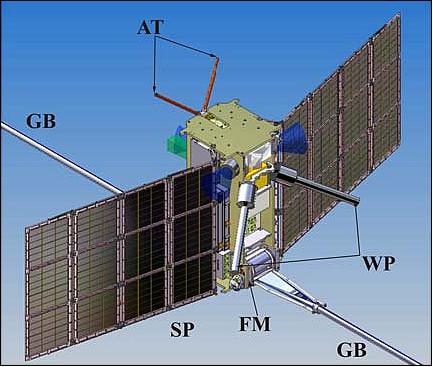
am 2. November 2011 dockte der Weltraumfrachter “Progress M-13M” an die ISS. Mit an Bord war der Mikrosatellit CHIBIS-M. Hauptaufgabe von CHIBIS-M ist die Untersuchung der physikalischen Prozesse in der Nähe von Gewittern, in denen die terrestrische Gammastrahlung (TGFs) generiert werden. Progress M-13 wird am 23. Januar 22:10 UTC von der ISS abdocken und nach zwei Korrekturen auf eine Höhe von 500km gebracht werden. In dieser letzten Phase wird CHIBIS-M dann am 24. Januar, 23:19 UTC in einem 500km Orbit separiert.
Neben wissenschaftlichen Daten (auf Kommando der russischen Bodenstation) wird zusätzlich Telemetrie im gewohnten RS-Satelliten CW-Bakenformat auf 435.315 MHz oder 435.215 MHz gesendet.
NASA Catalog: 38051
Downlink
435.315 MHZ (TXA) und 435.215 MHz (TXB) CW und FM (Data)
Status
nicht aktiv
Orbital Parameter
NORAD 38051 COSPAR designator 2011-062-C Inclination 51.647 RA of A. Node 114.877 Eccentricity 0.0011470 Argument of Perigee 254.178 Revs per day 15.21953629 Period 1h 34m 36s (94.60 min) Semi-major axis 6 878 km Perigee x Apogee 492 x 508 km BStar (drag term) 0.000515970 1/ER Mean anomaly 146.765
CW Telemetrie
Name Decoding parameters Assignment of parameters ------------------------------------------------------------------ RS 39 Callsign UBS U=N * 0.1 Volts On board voltage IBS I=N * 0.01 Amp On board current USUN U=N * 0.1 Volts Charge voltage from solar array ISUN I=N * 0.01 Amp Charge current from solar array ITXA I=N * 0.01 Amp DC Current of the 435 MHz Tx A ITXB I=N * 0.01 Amp DC Current of the 435 MHz Tx B TTXA T=N-128 °C Temperature of the 435 MHz Tx A TTXB T=N-128 °C Temperature of the 435 MHz Tx B TNAP T=N-128 °C Temperature of the navigation unit TAB T=N-128 °C Temperature on board battery MSEP Table of operational modes of the power supply MCON Table of operational modes of the controller SMA Table of operational modes of channel A SMB Table of operational modes of channel B MRXA Table of operational modes of Rx A (435.315 MHz) MRXB Table of operational modes of Rx B (435.215 MHz) RS 39 Callsign
rs39 ubs 140 ibs 90 usun 21 isun 0 itxa 0 itxb 0 ttxa 139 ttxb 138
tnap 137 tab 150 msep 0 mcon 5 sma 99 smb 94 mrxa 2 mrab 2
rs39 ubs 140 ibs 90 usun 22 isun 0 itxa 0 itxb 0 ttxa 137 tnap 136
tab 149 msep 0 mcon 5 sma 98 smb 95 mrxa 2 mrxb 2
rs39 ubs 139 ibs 96 usun 22 isun 0 itxa 0 itxb 0 ttxa 137 ttxb 136
tnap 135 tab 149 msep 0 mcon 5 ...
26.01.2012, 22:12 UTC
Science hardware
- X- and gamma-ray detector XGD (50 – 500 Kev) to record the sporadic increase (bursts) of penetrating X- and gamma-ray radiation of high-altitude atmospheric discharges.
- Ultraviolet detector UVD (300 – 450 nm) to record bursts of ultraviolet and infrared radiation of high-altitude atmospheric discharges.
- Radio frequency analyzer RFA (20-50 MHz) to provide reception of radio frequency signals in a frequency band of 26-48 MHz.
- Optical band camera DPC (spatial resolution of 300 m) to record a fact of lightning and projection of the lightning discharge on the clouds; reference of the discharge center to the coordinate system of DPC equipment.
- Data collection unit DCU-Ch to provide the command-data communication of Groza equipment with the onboard control complex.
- Scientific information transmitter to provide scientific information dump.
- Magnetic wave complex MWC (0.1 – 40 kHz) to measure electromagnetic parameters of “space weather”.
Datenübertragung

Nur im Bereich der Kommandostation aktiv. Die Übermittlung der wissenschaftlichen Meßdaten von CHIBIS-M findet außerhalb des Amateurfunkbereiches im S-Band auf 2270 MHz statt. Die primäre S-Band Tracking Station befindet sich in Tarussa, Russland. Die Kommandoübermittlung und der Telemetrie-Empfang wird von Kaluga, Russland aus kontrolliert.
435.215 MHz (TX B) – Modulation PM Manchester kodiert 4800 kbit/s (FM) 1136 bytes frame length
Ein kompletter Übertragungszyklus besteht aus 256 Frames inkl. Syncword und Framecounter. Ein kompletter Telemetriesatz besteht aus 128 x 256 Bytes (Daten aus 2 Rahmen).

WP (Wave Probe), FM (Fluxgate Magnetometer), GB (Gravity-gradient Booms), DM (Search-coil Magnetometer), AT (Telemetric Antenna), SP (Solar Panels)
Empfangsberichte und QSL
Das Team von RS-39 freut sich über jeden Empfangsbericht, besonders während der ersten Orbits. Jeder Bericht wird durch eine spezielle QSL-Karte bestätigt werden.
Berichte per e-mail bitte an : amateur-rs39@chibis.cosmos.ru

weitere Informationen
http://chibis.cosmos.ru
http://events.eoportal.org/presentations/190/10003641.html
PDF 2010 CHIBIS
PDF 2009 Chibis-M
